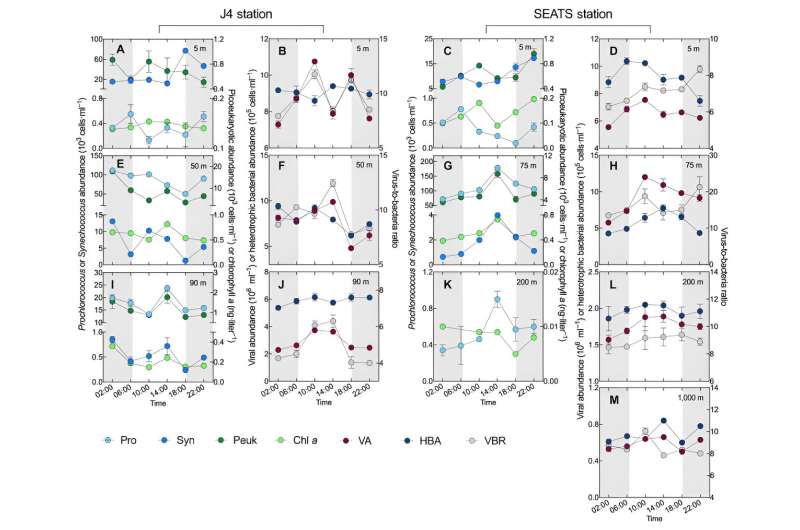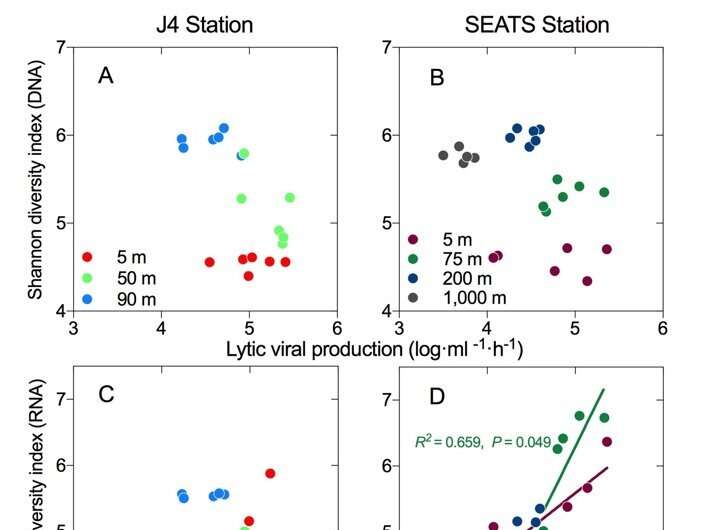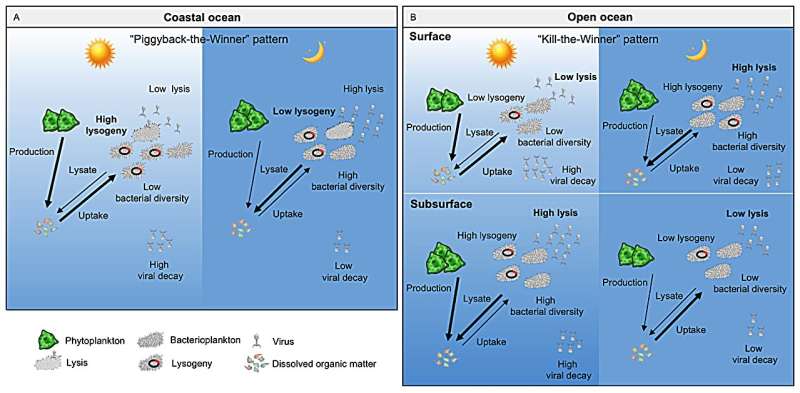This article has been reviewed according to Science X's editorial process and policies. Editors have highlighted the following attributes while ensuring the content's credibility:
fact-checked
peer-reviewed publication
proofread
Viruses as important factors driving the diel dynamics of marine bacterioplankton

The diel cycle is one of the most common periodic patterns in marine ecosystems. Previously, the diel rhythm changes of marine bacterioplankton have often been attributed to factors like bacterial light-dependent physiological mechanisms or their interactions with photosynthetic organisms.
However, the important role of viruses in these diel rhythm changes has been largely overlooked. As the most abundant, diverse, and dynamically varying life particles in the ocean, viruses are indispensable components of marine ecosystems. They regulate global biogeochemical cycles by infecting host bacteria. Previous research has already found that viral activity follows specific diel patterns.
For example, viruses that infect photosynthetic cyanobacteria are more infectious during the daytime and tend to become "dormant" at nighttime. However, there is still little known about how viruses in natural marine environments affect the diel rhythms of planktonic bacteria, which greatly hinders our accurate understanding of marine ecosystems.
A new study published in Research has discovered that virus-host interactions have different diel patterns in coastal and open ocean habitats, revealing that viruses are important factors driving the diel rhythm changes of marine bacterioplankton.
The team led by Professors Rui Zhang and Nianzhi Jiao at Xiamen University collected field samples over a complete diel cycle from different water layers in coastal and open ocean environments. They analyzed the interrelationships between viruses' abundance, production, decay, and infection strategies and the abundance, metabolic activity, community structure, and diversity of bacterioplankton, exploring the diel patterns of virus-host interactions. The research results show that the diel rhythms of virus-host interactions vary across different ecosystems and water layers.

Viruses in both coastal and open ocean surface waters exhibit a "night-production" pattern, characterized by low production and high decay rate during the day and high production and low decay rate at night. Meanwhile, the patterns vary in the chlorophyll maximum layer, the bottom of the euphotic zone, and the aphotic layer. Furthermore, the study found that on a diel time scale, the lytic effects of viruses are important factors inhibiting bacterial metabolic activity.
The research also discovered that the diel variations in bacterial communities in different habitats are significantly influenced by different viral infection strategies. In coastal areas, the diversity of bacterial communities shows a significant negative correlation with lysogenic viral production.
This suggests that increased lysogenic viral infections lead to a decrease in the diversity of host bacterial communities, providing strong evidence for the newly proposed "piggyback-the-winner" theory. In open ocean environments, however, there is a statistically significant positive correlation between the diversity of bacterial communities and lytic viral production.
This indicates that increased lytic viral infections lead to an increase in the diversity of host bacterial communities, which is consistent with the classic "kill-the-winner" model. This reveals that viral infections are important factors driving the diel dynamic changes in marine bacterial communities.

Therefore, the study reveals that the classic "kill-the-winner" and the newer "piggyback-the-winner" theories are not in opposition but serve as complementary, co-existing viral ecological strategies. This reveals that virus-host interactions have different patterns in different ecological environments.
This study identifies viruses as an important factor driving the daily variations in bacterial communities. The patterns of virus-host interactions revealed by this research also offer a new perspective for exploring the contributions of viruses to marine biogeochemical cycles.
This suggests that the selection of different viral infection strategies can not only regulate the structure of host communities but also influence marine carbon cycles and global climate change by affecting the dissolved organic matter pool. Future research will need to delve deeply into the processes and ecological importance of lytic and lysogenic virus-host interactions in various ecological environments and on different time scales.
More information: Xiaowei Chen et al, Virus–Host Interactions Drive Contrasting Bacterial Diel Dynamics in the Ocean, Research (2023). DOI: 10.34133/research.0213
Journal information: Research
Provided by Research




















